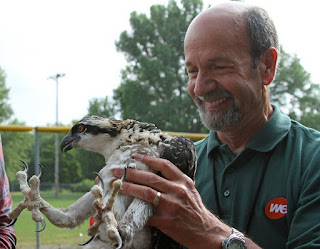 |
Twitter follower alerted us.
|
Two rounds of storms caused power outages to more than 26,000 customers in our service area over the weekend.
We often see tree branches come in contact with our equipment and cause outages. Other unusual debris, however, also can become entangled in our wires.
In the town of Genesee, Wisconsin, one of our Twitter followers alerted our crews to a trampoline that was entangled in wires.
We often see tree branches come in contact with our equipment and cause outages. Other unusual debris, however, also can become entangled in our wires.
In the town of Genesee, Wisconsin, one of our Twitter followers alerted our crews to a trampoline that was entangled in wires.
Troubleshooter Scott Kirchoff was the first to arrive on scene. “You never know what’s going to happen when you come into work. It was something you don’t see every day,” said Kirchoff.
Witnesses told our crews the trampoline flew into the air, sailed over a farm house, soared across the highway and then landed on our wires. As with any good stories, witnesses had different claims of how far up in the air the
trampoline reached. Most answered between 50 and 100 feet.
 |
Trampoline on wires in Genesee.
|
The incident caused 70 customers to lose power.
Kirchoff assessed the situation and decided he needed a crew with specialized equipment to help with the situation. He also called local authorities to help with traffic control as many people were stopping to look at the strange sight.
The trampoline was still rocking back and forth on the wires when Line Mechanic Dart Ellsworth arrived in his bucket truck.
Ellsworth said, “It was definitely interesting. It was a challenging project, but we were able to remove it safely. “
Dave Megna, vice president – Wisconsin system operations, says all sorts of objects, such as aluminum lawn furniture, have been tossed around into our wires during storms.
“This incident is a good reminder to secure objects that can easily fly around during high winds,” said Megna.
This incident did not cause downed lines, but if you come across downed power lines, or anything touching those lines, stay at least 25 feet away and call 911 or 800-662-4797.
Kirchoff assessed the situation and decided he needed a crew with specialized equipment to help with the situation. He also called local authorities to help with traffic control as many people were stopping to look at the strange sight.
The trampoline was still rocking back and forth on the wires when Line Mechanic Dart Ellsworth arrived in his bucket truck.
Ellsworth said, “It was definitely interesting. It was a challenging project, but we were able to remove it safely. “
Dave Megna, vice president – Wisconsin system operations, says all sorts of objects, such as aluminum lawn furniture, have been tossed around into our wires during storms.
“This incident is a good reminder to secure objects that can easily fly around during high winds,” said Megna.
This incident did not cause downed lines, but if you come across downed power lines, or anything touching those lines, stay at least 25 feet away and call 911 or 800-662-4797.







